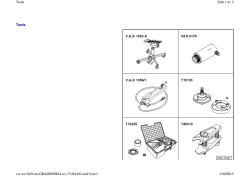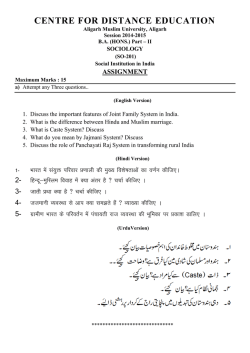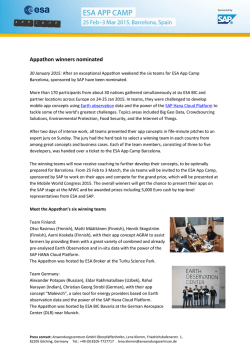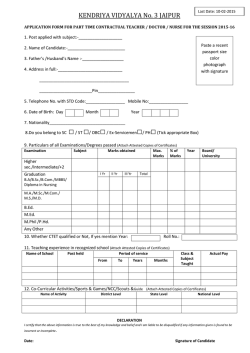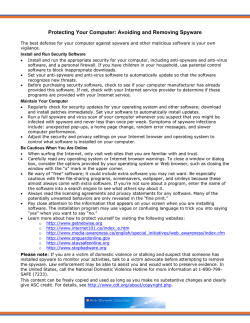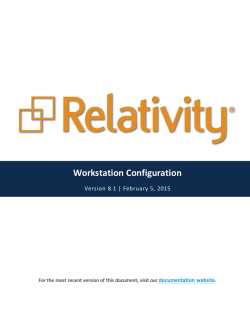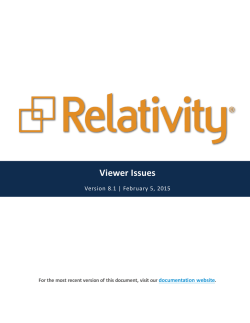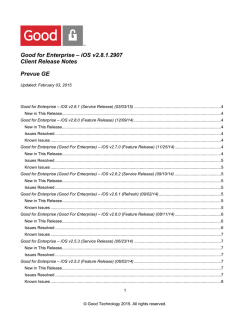
Short Resume
vaPV (voice activated Procedure Viewer) Type A Contract SyberNet Ltd. Inventor Introduction The original proposal described an on-board voiceactivated crew assistant that would enable the crew of a space mission navigate detailed documents using speech commands. The primary objective of the proposal was to research the opportunity and effectiveness of providing an alternative interface for astronauts who needed to access detailed information in “hands-busy” or “eyes-busy” situations. With input from ESA the original proposal was refined to focus on integrating a speech command and control interface into an existing procedure document viewer already established and deployed within the space community. This viewer is called the International Procedure Viewer or (iPV) and is the result of a joint collaboration between NASA and ESA. The Innovation The key innovation of the proposed solution was to enhance an existing legacy application by adding new modes of interaction to it. Developing multimodal desktop applications is a new and challenging area for software developers, especially in situations where new modes of interaction have to be integrated into existing operational systems. The IPV (International Procedure Viewer), used by all astronauts on the International Space Station when carrying out nominal and detailed maintenance work, was an excellent candidate for multi-modal use. Multi-modal access to this tool offers the advantage to users of being able to interact with the documentation system in situations when they may not have easy access to the laptop keyboard. Currently, IPV provides visual-only output, via a display, and uses the keyboard and mouse as its input devices. The work carried out as part of this activity added: a) a voice command modality, in addition to the standard keyboard input, and, b) an optional Text-To-Speech audio output that presents the text of the document to the user aurally. Results of the ITI activity Two new modes of interaction were added to the existing IPV tool, namely, • voice commands for input, and, • text rendered as speech, and presented to the user as an aural output through the laptop audio device Because it was a legacy application, with a widespread user community within ESA, there were some constraints enforced on the project. These were the following: 1. IPV was developed with Microsoft’s IE explorer browser as the target end user browser. No other browser would work so any new technology had to be compatible with IE Explorer 6.0+ 2. IPV procedure content is stored as XML and is transformed by XSL templates to be presented as HTML in the browser. Any speech enabling activities would have to follow a similar process in order to preserve the synchronisation required betweens modes of interaction i.e. the active step’s associated voice prompt had to be in synch with the highlighted step displayed on the screen and vice versa. 3. The XML structure and content for a procedure could not be modified. The structure is an internationally agreed standard and the content is an operational product under configuration control. Any additional tagging required to support the voice modality had to be introduced dynamically. The modified IPV tool also had a new visual indicator to display the status of the voice subsystem. This is indicated in the following iPV screen capture. The following drawing gives an overall architecture of the data flow within the IPV application and indicates where the new voice-enabling component has been added within the existing environment. All key constraints were met. In particular, there was no requirement to change the underlying XML format for the documentation in order to add the voice tagging needed. XML Formatted Procedure (Unmodified) Future applications The concept, developed as part of this proof of concept activity, has been proposed as an addition to the future Columbus system laptop framework, (LAPAP MkII), developed by Astrium. Skytek, another space development company, have already built a Java-based Checklist procedure viewer for the LAPAP environment and a proposal to provide a voice commanding capability for this viewer is currently being prepared. The proposal, a collaboration between Astrium, Skytek and SyberNet, would provide a voice commanding capability as a plug-in component in the LAPAP MKII framework. TOMCAT Container vaPV XSL Filter Rules for Voice Recognition Java Servlet XML Filter Existing XSL Filter Rules for Visual Presentation DHTML document marked up with Voice Enabling tags for processing in the browser Contacts Keyboard IE Explorer Browser with Speech Add-In SAPI ASR Engine SAPI TTS Engine Mouse User Mr. John Melody, SyberNet Ltd, Galway Business Park, Dangan, Galway, Ireland [email protected] Mr. Mikael Wolff, ESA Project Officer, Noordwijk, The Netherlands, [email protected]
© Copyright 2025
